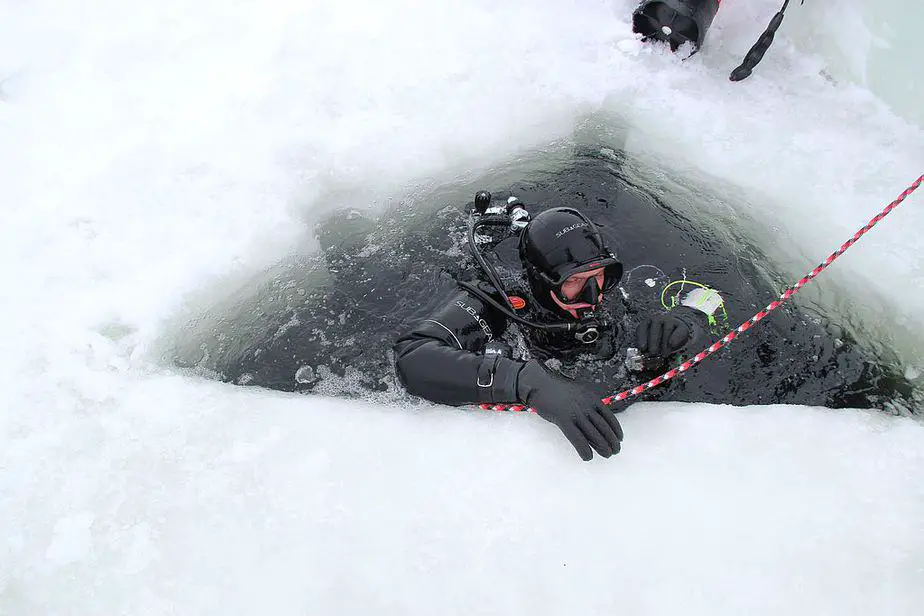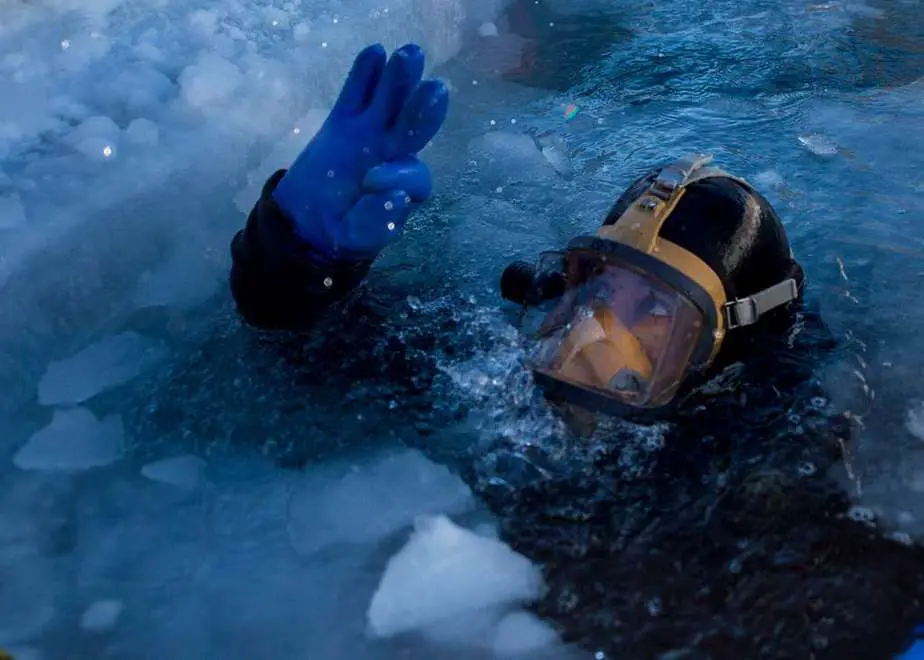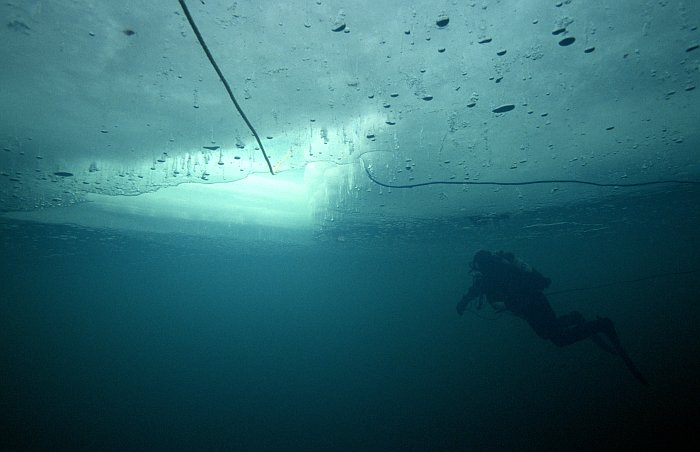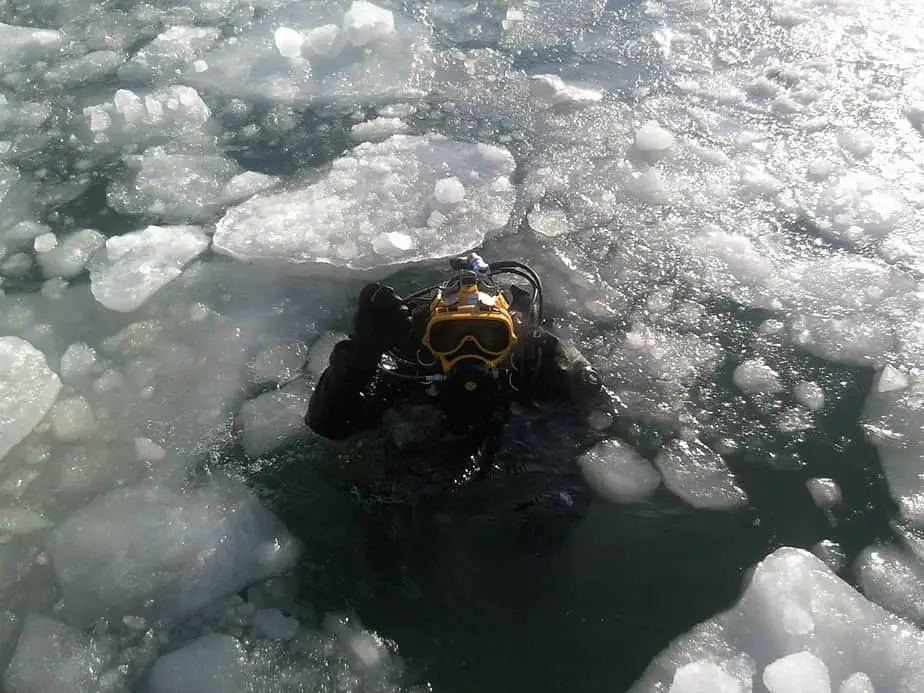When it starts to get a bit chilly, most scuba divers hang up their kit for the season and wait for warmer weather. For some, the opposite is true. When they look out their window during the heart of winter and see their surroundings gently coated in a layer of snow, they think to themselves, it’s a great day to go ice diving.
If you think it’s a shame that you can only dive a few months of the year and just want to be able to dive year round, then you might want to take up ice diving. This type of diving demands a very specific skill set and gear, but it’s worth it to dive in the clearest, most beautiful still water you’ll ever see. Ice diving is an interesting option for thrill-seeking divers that want to challenge themselves. Once the temperature drops, the time is ripe for ice diving and this article aims to provide some basic information to help you get started.
What is ice diving?
Donning a drysuit and numerous thick undergarments, you and your dive team walk out onto a frozen lake. With the pull of the cord, the chainsaw roars to life and begins to cut through three-feet of solid ice to reveal the water below.
You drop in the hole with your gear and safety line, and some of the 34°F (1°C) water touches your face. The water is so cold it feels like your exposed skin just got pierced. But despite the numbness of your face, your attention quickly shifts to the textures and ethereal lighting of the under-ice environment. Ice diving is unlike anything you’ve seen before.
Ice diving, not to be confused with cold-water diving, is when you dive beneath a large layer of ice that either partially or entirely covers the top portion of the dive site. In other words, ice diving is diving in cold waters in an overhead environment, whereas cold water diving is done in near-freezing temperatures with no ice above.

As you can imagine, diving in temperatures that can give an ill-equipped diver hypothermia in a matter of minutes, in an overhead environment, sounds like a recipe for disaster. Therefore, for a diver to safely dive under the ice, they need to take proper precautions.
For instance, even though there is only one ice diver, they are supported by a team above that monitors their progress. The diver will be tethered to a safety line, and this is a means for communication as well as a lifeline to pull the diver out if needed. The diver wears a specialized harness which the line clips to such that it doesn’t interfere with the other equipment.
The dive buddy team for ice diving consists of two to four members, including the diver. The remaining members perform a supporting role at the surface to ensure the diver’s wellbeing. If the diver is using recreational scuba equipment, then dive times are generally limited to a maximum of 30 minutes. This time limit keeps divers from being exposed to freezing temperatures for too long, and is done as a precaution to prevent any out-of-air problems.
Why should you ice dive?
As you can see, ice diving is quite involved, and is not without its share of risks. So why would someone decide to subject themselves to such an extreme sport? For starters, the opportunity to see leopard seals and penguins seems enticing, however those are only found in the Arctic. Ice diving can also be done in much of the Northern hemisphere and even some of the Southern hemispheres can experience below-freezing temperatures during the winter.
In other words, some marine and freshwater bodies may be partially or completely covered in ice and snow. If you can’t afford diving in a tropical paradise, then how about going in the opposite direction and enjoy winter diving in your own backyard? Why must you hang up your scuba kit just because it got a bit chilly outside?
Another attraction for ice diving, other than its beautiful surface layer, is the unique animal experiences and dive activities that you could not do anytime else. During the winter, cold-blooded aquatic animals decrease their metabolisms to conserve energy, meaning they are much more lazy and docile than usual.
As a diver, you rarely get an opportunity to calmly approach fish or invertebrates without them moving. A cool thing you can do as an ice diver is to fully inflate your drysuit and invert your positioning such that you are standing on the ice upside-down. Now, you can observe these animals from a truly unique perspective.
Furthermore, the near-freezing temperatures of the water has inherent benefits as well. Freshwater bodies tend to be exceptionally clear in the winter due to the decreased water circulation which allows the particulate matter to remain undisturbed. Thus, objects and animals you may not have been able to see in the summertime become visible under ice. By braving the ice-cold water temperatures, you are rewarded with more underwater clarity than any other time in your diving career.
Diving as a team

The buddy system works differently when you’re ice diving. Normally you would be diving alongside a few other divers, but only one member from the team should be diving with the rest staying at the surface. Perhaps you’re already used to solo diving, however just because no one is diving next to you doesn’t mean you’re actually alone.
Learning how to ice dive doesn’t just give you the skills to dive in this extreme overhead environment; it also improves your teamwork skills. The surface team members provide support to the ice diver by assisting in navigation and ensure the diver’s safety. Here’s how they do that.
There are four positions for each member: 1) diver, 2) tether, 3) bucket, and 4) safety diver. The diver must be tied or clipped to a lengthy rope, and this rope is held taut on the surface by the members in the tether and bucket role. The tether tugs the rope to communicate to the diver, and the bucket keeps the rope from going slack in the bucket.
The safety diver is fully suited up and prepared to dive under the ice at a moment’s notice to retrieve the first diver in the event of an emergency. When you take the Ice Diver course, you’ll get a chance to perform each role so that you know the ins and outs of ice diving.
How do you know if you’re ready to ice dive?
Due to the extreme nature of ice diving, it is obviously not for everyone. At the same time, ice diving is a lot more manageable than you’d think due to the unique buddy system and numerous safety precautions you should be following. Recreational divers can take the ice diver course and excel in ice diving without any technical training.
Unfortunately, there aren’t many places that offer a “try ice-diving” experience, so you pretty much have to be in love with the idea of ice diving because your first experience with it is probably going to be the specialty course offered by PADI and NAUI. As part of the course, you’ll go on six short training dives. Upon successful completion, you will be a certified ice diver.
To meet the enrollment requirements, divers must have a minimum of 100 logged dives, an Advanced Open Water Diver certification, and some drysuit experience. Since most frozen lakes are at altitude, you must be familiar with altitude diving dos and don’ts as well which are taught in the Altitude Diver course. We recommend spacing out these courses over a period of a few months. Achieving these certifications at the same time in preparation for ice diving is not unheard, but quite difficult.
Ice diving equipment
Most of your regular scuba diving equipment, such as your mask, gauges, dive computer, and so on should still work in ice water. You may not have worn dive gloves or a dive hood before, but now you absolutely must prevent as much skin exposure to the water as possible.
Specifically, you want dry gloves and a dry hood, though neoprene gloves work fine if you don’t feel like buying another pair. A form-fitting dry hood will keep your head and neck more snug and warm than the standard tuck-in style neoprene hood. Whichever hood you decide to use, make sure it doesn’t interfere with your dry seals.
Next, a full-face dive mask can stop water from coming into contact with your face. However, a regular dive mask works fine. Simplicity is crucial when learning new skills, and you may find numb cheeks to be preferable to dealing with a full face mask during training. Furthermore, if people realize that most of their old scuba gear is perfectly suitable for ice diving, it lowers the barrier of entry of this daunting sport.
With that said, two special considerations must be made for your regulator and exposure suit. When diving under ice, you cannot use your standard regulator and wetsuit because they are no longer adequate. You must upgrade them to a cold water regulator and a drysuit.

Standard regulators are designed to function in water temperatures above 41°F (5°C), and ice water is as cold as 34°F (1°C). At this temperature, ice crystals can form in the regulator’s internal components. Certain components can freeze in an open position, causing the regulator to free-flow. No bueno.
A cold water regulator will avoid this problem. To do so, manufacturers have installed chambers in the first stages that are filled with non-freezing liquids. These allow your first stage to operate like normal in freezing water without freezing. Nearly every manufacturer sells environmentally-sealed or cold water regulators.
Drysuits are also essential for staying warm. If you know how a wetsuit works, you’ll know that they don’t keep you dry, and letting ice water in your exposure suit is a big no-no. Any drysuit is adequate for ice diving; the important part is the undergarments underneath, not the suit itself. Some manufacturers make thick undergarments just for ice diving, but these are expensive.
If you already have winter gear, see if you can fit that under your drysuit. Puffy down coats are ideal, vests work great, and wool layers are also an option. We recommend wearing several pairs of thick hiking socks at once to keep your feet nice and cozy.
Ice diving photography tips
Some divers get into ice diving because they want to challenge themselves, experience a new type of diving, and maybe they are a little masochistic. If you are an underwater photographer or videographer, your reason for bringing your camera with you while ice diving is most likely to capture the beautiful, heavenly lighting that illuminates aquatic life under the ice.
The way light penetrates the snow-covered ice comes from the occasional crack, hole, or clear lines on the ice surface, similar to how light illuminates a cave or cavern. When the light hits an animal, it honestly looks like an ethereal creature that descended from the heavens itself. Combine this with the exceptional water clarity, and a coastline or frozen lake turns into a one-of-a-kind studio set. All you need is the right camera equipment to seal the deal.
Here are some tips for underwater photographers to take the perfect shots under the ice.
- Get proficient at ice diving before you bring your camera. You might think that diving with your camera is part of the learning process, but actually it becomes extremely dangerous if you aren’t yet familiar with the safety procedures. With so many new things to learn, bringing a camera too soon is a bad idea.
- Consider how the freezing temperatures will affect your gear. Did you know that lithium batteries drain faster when they are cold? Remember to fully charge your batteries and bring a backup battery. Also, your lens port may fog when you take it out of your warm car into ice water. Consider using moisture packets and keep your camera housing out of direct sunlight.
- Dry your housing after diving. Any droplets of water will freeze after a dive. When water turns to ice, it expands, and this can crack your housing or prevent knobs or levers from operating. Thus, dry it as soon as possible after a dive.
- Discuss communication methods with your team. It’s standard procedure for the diver to have a safety line tethered to them, and for the person in the tether role to pull on it. Unfortunately, your buddy may jerk your arm right when you got the perfect shot lined up. Since you still need to be safe, see if you can come up with a new method. However, you should prioritize your safety over your photography opportunities.
What happens if I am stuck under the ice? Can I break through it from below?
One question people who are looking to become ice divers often wonder is whether they are physically strong enough to break through the ice if they can’t get to the exit for some reason. The short answer is: probably not.
In order for an ice diver to break the ice from underneath, the ice would have to be pretty thin, or the diver must possess superhuman strength. In case you forgot, most ice diving is done under a few feet of ice. The dive team needs to first make a hole by cutting through the ice with a chainsaw.
Any layer of ice that is thicker than a few centimetres is pretty much impossible for the diver to break through. Ice is way sturdier and durable than you might think. Perhaps you’ve seen videos of people trying to “cannonball” into their frozen swimming pool, only to land flat on their bottoms.
If you find yourself beneath that much ice, you couldn’t punch it, cut through it, or do much of anything by yourself. There’s also the issue of leverage. Since a diver is floating in the water, they have no surface which they can push off of, so it’s hard to generate enough force. With all of these factors against the diver, they pretty much are at the mercy of their surface team.
Should the situation be so dire that you cannot even wait for your dive buddy group to assist you, your only other hope is to try to find a hole or a cracked section of the ice to try to escape through.

